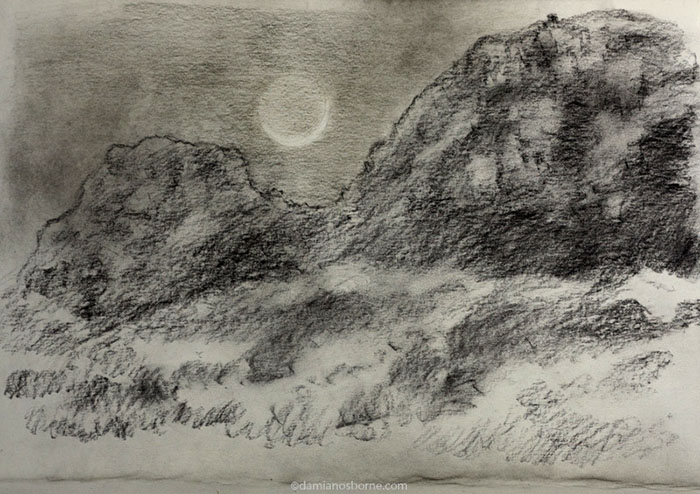Click to view the painting.

A Little Nocturne Oil Painting
Light the scented candles, put on that old Chopin CD and pour another glass of red. I’m in the mood for a little nocturne oil painting.
This scene made a very strong impression on me as I regarded the crescent moon hanging like a shining eyelash between the mountain buttresses one evening.
It’s a little corner of wildness, this exposed section of the peninsula at the end of the mountain range, with incessant gale-force winds from the sea, slamming against the rock faces and my back.
The fynbos-covered slopes seem to dance in waves and ripples. Yet, juxtaposed above, the moon imparts an eternal calmness on the scene.
I did a rough charcoal sketch in my sketchbook that evening, wondering how I would capture the scene in oils. What pigments would I use for a nocturne painting? Photographs certainly provide no accurate colour reference.

What pigments can be used for a nocturne oil painting?
For this nocturne oil painting, I used a very limited palette of bone black, red ochre, yellow ochre, and titanium white. Keeping to a limited palette allows me to maintain a more subtle and subdued colour harmony. See Zorn colour palette.
At night, under the moonlight, colours are obviously less bright and less saturated.
We see objects as more greyed; we are unable to differentiate colours, values and contrast to the same degree as in the daytime. Reds and greens are particularly difficult for our eyes to discern in darkness.
Colour temperatures, therefore, appear cooler at night. To counterbalance these cool-toned colours, I toned the canvas board with a warm earthy red ochre.
Painting on a warm-coloured ground, the cool greys, browns and blues appear more harmoniously balanced. This creates a very subtle, desaturated blue-red split complementary colour harmony.
I used only my own pigments for this painting. The ochre I gathered from a vineyard in Constantia. I maintained a fire for 10 hours, calcining bones to make black.
Using my own hand-refined linseed oil and calcium carbonate (chalk), one can get a diverse range of textures and viscosities unachievable with commercial, homogenously ‘buttery’ oil paints which contain waxes and fillers.
The use of a chalk medium helps to create more variation in transparency with even ‘opaque’ pigments.
See more Landscape Paintings
- What’s the Point of Creating When No One Cares? - 24th August 2025
- Fantasia No.6 in G minor (The Cockatrice) - 3rd May 2025
- Rebirth: Starting Over as an Artist — Part 1 - 17th April 2025
